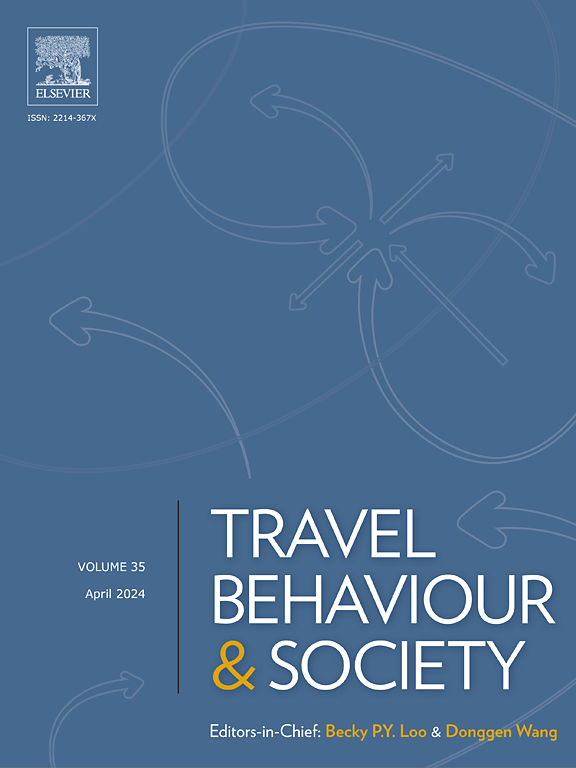What makes a commute enjoyable: A duration close to the ideal, or far below the maximum tolerable?
IF 5.7
2区 工程技术
Q1 TRANSPORTATION
引用次数: 0
Abstract
Many studies have found that commute duration negatively impacts commute satisfaction. However, the relationship of commute time with people’s ideal and maximum tolerable commute times, and how these affect commute satisfaction have not been explored in detail. In this study, using data from 2,378 students and staff members of University College London (UCL), I explore actual, ideal and tolerable commute times for various travel modes and analyse how the differences between actual commute time and i) ideal commute time and ii) maximum tolerable commute time influence commute satisfaction. Results show that travel times are considerably longer for public transport users (especially train users) than for active travellers, and that – partly as a result – public transport users’ commute durations are often considerably longer than the desired commute durations, and close to the maximum tolerable commute durations. For active travellers, on the other hand, commute durations are generally closer to the ideal durations than to the tolerable durations. Both the ideal and the maximum tolerable commute duration are strongly affected by the actual commute duration, suggesting that people adjust their ideal and tolerable commute time so they better match the actual commute time. Finally, results show that having a commute duration close to the ideal, or far below the maximum tolerable has a stronger impact on commute satisfaction than the actual commute time. Improving commute satisfaction by closing the gap between actual and ideal commute duration and increasing the difference between actual and maximum tolerable durations, could be realised by creating more compact, mixed use neighbourhoods where it is easy to walk and cycle and have low actual commute times. Additionally, results suggest that enhancing people’s travel attitudes can increase both ideal and maximum tolerable commute times, thereby bringing the actual and ideal commute time closer to each other.
是什么让通勤变得愉快:持续时间接近理想状态,还是远远低于可忍受的最长时间?
许多研究发现,通勤时间会对通勤满意度产生负面影响。然而,通勤时间与人们的理想通勤时间和最大可容忍通勤时间的关系,以及它们如何影响通勤满意度的研究尚未得到详细的探讨。在这项研究中,我使用来自伦敦大学学院(UCL) 2378名学生和工作人员的数据,探讨了各种出行方式的实际、理想和可容忍通勤时间,并分析了实际通勤时间与I)理想通勤时间和ii)最大可容忍通勤时间之间的差异如何影响通勤满意度。结果表明,公共交通用户(特别是火车用户)的出行时间比活跃的旅行者要长得多,部分原因是公共交通用户的通勤持续时间往往比期望的通勤持续时间长得多,接近最大可容忍的通勤持续时间。另一方面,对于经常出行的人来说,通勤时间通常更接近理想的持续时间,而不是可容忍的持续时间。理想通勤时间和最大可容忍通勤时间都受到实际通勤时间的强烈影响,这表明人们需要调整自己的理想通勤时间和可容忍通勤时间,使其更符合实际通勤时间。最后,研究结果表明,通勤时间接近理想值或远低于最大可容忍值对通勤满意度的影响大于实际通勤时间。通过缩小实际和理想通勤时间之间的差距,增加实际和最大可容忍持续时间之间的差异,提高通勤满意度,可以通过创建更紧凑的混合用途社区来实现,这些社区便于步行和骑自行车,并且实际通勤时间较短。此外,研究结果表明,提高人们的出行态度可以增加理想通勤时间和最大可容忍通勤时间,从而使实际通勤时间和理想通勤时间更加接近。
本文章由计算机程序翻译,如有差异,请以英文原文为准。
求助全文
约1分钟内获得全文
求助全文
来源期刊

Travel Behaviour and Society
TRANSPORTATION-
CiteScore
9.80
自引率
7.70%
发文量
109
期刊介绍:
Travel Behaviour and Society is an interdisciplinary journal publishing high-quality original papers which report leading edge research in theories, methodologies and applications concerning transportation issues and challenges which involve the social and spatial dimensions. In particular, it provides a discussion forum for major research in travel behaviour, transportation infrastructure, transportation and environmental issues, mobility and social sustainability, transportation geographic information systems (TGIS), transportation and quality of life, transportation data collection and analysis, etc.
 求助内容:
求助内容: 应助结果提醒方式:
应助结果提醒方式:


